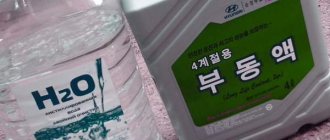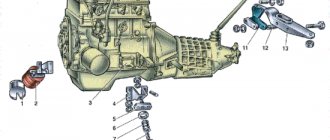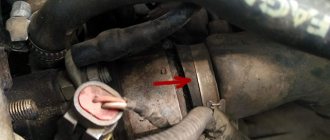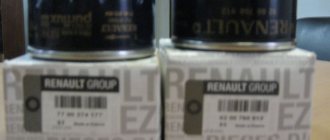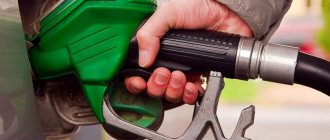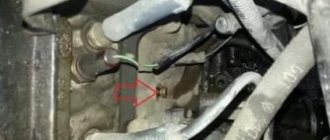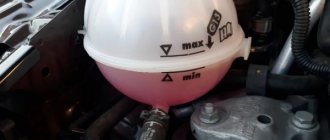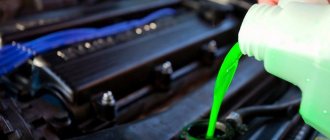What's better
In Russia, there is a widespread dispute over two coolants: antifreeze and antifreeze. But it’s stupid to compare them, since antifreeze is a Russian-made antifreeze. This is what worries car enthusiasts: many are afraid of counterfeits and performance characteristics. Therefore, some car owners do not pour antifreeze into expensive cars, trusting more in the properties of antifreeze.
There is a risk of getting a fake. At the same time, both domestic and foreign antifreeze are counterfeited. However, the latter is counterfeited less often. The list of differences that antifreeze and antifreeze have is small:
- color;
- package;
- name of antifreeze.
To understand in more detail the differences between antifreeze and antifreeze, you should briefly study the theory. Coolant consists of ethylene glycol compounds, water and additives . The differences between mixtures from different manufacturers depend on their quantity. Additives are responsible for preventing corrosion processes.
There is an opinion that antifreeze and antifreeze should differ in color. But production technology does not affect the shade in any way. It is affected by the dye. Antifreeze and antifreeze liquids can be either red, blue or green. Even if the substance has an original color, it may be the tricks of marketers. And here it all depends on the dye.
Another common myth: antifreeze is more suitable for foreign cars, and antifreeze is more suitable for domestic cars . There is some truth, since the domestic product is manufactured with Russian engines in mind. But breakdowns still happen.
However, the instructions do not specifically mention individual brands. It all depends on performance and characteristics. Therefore, it is better to pay attention to the antifreeze manufacturer.
Advantages and disadvantages of antifreeze and antifreeze Antifreeze, advantages:
- cheap;
- changes color as it ages.
Minuses:
- negatively affects the water pump, which leads to its rapid failure;
- reduces the life of the radiator due to its effect on aluminum and the tendency to form condensation;
- enough for a maximum of 40,000 km of travel.
Antifreeze, advantages:
- lasts a long time;
- the engine runs for a long time without overheating;
- long service life of the radiator;
- no condensation forms;
- antifreeze has no harmful effect on metal;
- does not affect the pump.
The only drawback that antifreeze has is the price.
It is also necessary to compare the technologies of the compositions used to produce antifreeze and antifreeze. There are three main ones.
- Traditional. Additives are used that are formed on the basis of nitrates, phosphates, silicates, that is, salts of inorganic acids.
- Carboxylate. Salts of organic acids, that is, carbonates, are used here.
- Hybrid. The basis of the liquid is organic additives, but there is also a small amount of phosphates or silicates.
Domestic antifreeze is produced using traditional technology, while foreign antifreezes are produced using carboxylate technology. Therefore, it is better to use antifreeze for cars of domestic origin. For an expensive foreign car, it is better to use antifreeze. The price is higher, but the performance properties of antifreeze are better.
Auto repair school – DIY car repair
Oct 26, 2015 Tips by admin
Very often, car enthusiasts do not pay due attention to the coolant in the engine cooling system , and in most cases, not only do they not change the coolant at all, but they do not even know what exactly is poured into the engine cooling system of their car. Such carelessness is in vain. , further maintenance of the entire vehicle depends on the correct choice between antifreeze and antifreeze And so, let's figure out which is better - antifreeze or antifreeze .
This division of coolants into antifreeze and antifreeze exists only in Russia. The origin and history of TOSOL have already been repeatedly described in various media. According to Arteco, up to 22% of all breakdowns are directly, and 40% are directly or indirectly related to the engine cooling system. Therefore, paying proper attention to cooling and choosing the right coolant can help save money and time.
The composition of lubricating coolants includes mixtures of ethylene glycol (occasionally containing mixtures of propylene glycol), water and a whole package of corrosion inhibitor additives. Coolants from different manufacturers differ from each other precisely in the production technology of the additives included in their composition.
When choosing a lubricating coolant for your car, first of all you need to study its operating manual or service book to find out the recommendations of the car manufacturer and possible nuances of using a particular fluid known to the latter. In such a manual, the automaker can prescribe specific manufacturers and names of cutting fluids that have successfully passed all tests and tests (laboratory, bench, operational) conducted by the automaker, or prescribe the class of such fluids. These include liquids produced using one of the following technologies:
- traditional - contains additive packages based on salts of inorganic acids (nitrates, nitrites, borates, silicates, phosphates, amines),
- carboxylate (OAT) – the composition includes additive packages based on salts of organic acids (carbonates),
- hybrid – a type of carboxylate technology in which additive packages are created based on salts of carboxylic acids with minor additions of silicates and/or phosphates).
The Russian market is dominated by cutting fluids produced using traditional ( antifreeze ) and carboxylate ( antifreeze ) technologies.
Antifreeze has many advantages over antifreeze, which you should definitely familiarize yourself with:
- Increased efficiency of the engine cooling system.
Coolants produced using traditional technology form a protective layer on the metal surface, which can reach 0.5 mm.
Although this layer protects the metal from corrosion, it at the same time significantly impairs heat dissipation (up to 50%) due to its very low thermal conductivity. Thus, antifreeze works as a kind of insulator, worsening heat transfer. Consequently, the engine starts to operate at a higher temperature than intended and recommended by the car manufacturer. This in turn leads to faster engine wear, as well as reduced power and higher fuel consumption.
Carboxylate coolants, such as CoolStream, are characterized by increased engine cooling efficiency. These liquids form a protective layer exclusively in those places where corrosion forms 0.0006 mm (60 angstroms). And since no protective layer is formed on the rest of the inner surface, heat dissipation does not deteriorate.
2. Longer life of carboxylate coolant (antifreeze)
Antifreeze additive packages consist of compositions of salts of inorganic acids (nitrates, borates, silicates, phosphates, nitrites).
It is safe to say that in the production of 90% of domestic coolants, corrosion inhibitors such as silicates and nitrites are used. In this case, silicates are added primarily for the purpose of anti-corrosion protection of aluminum, and nitrites are added for the purpose of protection against cavitation erosion. The packages of these additives are balanced, but if the composition is disrupted due to faster consumption of one of the components, the coolant loses its beneficial properties. As can be seen in the graph below, silicates and nitrites are depleted first, and after 30-40 thousand kilometers of a car, coolant based on them almost completely loses its protective qualities.
At the same time, antifreezes produced using carboxylate technology remain stable for almost the entire period of use. Thanks to the protection, which only acts in the areas that need it, the consumption of additives occurs much more slowly. For example, for this reason, the service life of CoolStream Premium antifreeze reaches 250 thousand km or 5 years of operation for passenger cars, and 650 thousand km for trucks; and the service life of CoolStream Standard antifreeze is 100 thousand km or 2 years of operation.
3. Excellent protection for aluminum at high temperatures
In the process of building modern cars, aluminum is increasingly used as a structural material. And this trend of recent times is poorly combined with coolants produced using traditional technology - antifreeze .
The main disadvantage of antifreeze is the inability of its additives based on inorganic compounds to protect aluminum at high temperatures - above 105 ºC Celsius, and at high heat flows. For this reason, most automakers have stopped using antifreeze in their cars.
On the contrary, carboxylate antifreezes best protect structures made of aluminum and its alloys.
For clarity, the table shows comparative results of a high-temperature dynamic test for corrosion of aluminum in different coolants, proving the superiority of carboxylate liquids over traditional ones.
4. Extending the life of the water pump up to one and a half times
The main cause of water pump wear is hydrodynamic cavitation. This physical process involves the formation and collapse of coolant gas bubbles at the surface of the moving pump blades. When gas bubbles pop, hydrodynamic microimpacts occur on the surface of the blade, which tear out molecules. With frequent use and prolonged exposure to such micro-impacts, cavities (sinks) are formed and the blades are destroyed.
Unfortunately, so far none of the existing coolants can chemically protect the pump blades, completely preventing this physical process.
However, unlike traditional coolants, carboxylate antifreezes, due to the “targeted” nature of their protection, reduce the effects of cavitation and thus increase the service life of the water pump by up to 50%.
5. Excellent protection against cavitation of engine cylinder liners
Cylinder liners are also subject to significant influence from hydrodynamic and high-temperature cavitation. You can see for yourself the validity of the statement about the effectiveness of carboxylate antifreeze protection of cylinder liners by looking at the photo from 2007, which shows a cylinder of a Renault MIDR Y41 engine installed on a MAZ 103-41 bus with a mileage of 230 thousand km.
- 6. High stability of the qualities and properties of antifreeze.
Traditional coolants use silicates, which have the negative property of forming gels. Liquids containing phosphates can form insoluble fractions that precipitate. This sediment, along with gels, blocks the operation of the thermostat and clogs the radiator, and ultimately disrupts the operation of the engine cooling system.
Carboxylate antifreezes are characterized by high stability of quality and the absence of the formation of gels and sediment during use.
7. Increased compatibility with elastomers and plastics.
The cooling system of automobile engines uses plastic, elastomeric, rubber-silicone and other similar materials, to which carboxylate antifreezes are absolutely non-aggressive. This fact is confirmed by 15 years of practical testing carried out by Arteco, millions of kilometers and thousands of hours of engine operation. And as a sign of confidence in the results of these tests, a large number of automakers include antifreezes based on Arteco carboxylate additives in the list of recommended coolants.
8. No deposits or blockages in the radiator.
Coolants produced using traditional technology tend to form sediments and small insoluble particles, which impair heat transfer and clog the radiator. Whereas carboxylate antifreezes do not have such negative qualities and do not form deposits and blockages during the entire period of their use.
Antifreeze Antifreeze
9. Environmental friendliness of carboxylate corrosion inhibitors.
Thanks to the extended service life (antifreeze under the CoolStream Premium brand has 250 thousand km or 5 years for passenger cars, or 650 thousand km for trucks), the amount of used coolant that must be disposed of is automatically reduced.
Carboxylate-based corrosion inhibitors have a lower class of harmfulness and environmental hazard, so they are more environmentally friendly than traditional inhibitors.
10. Excellent stability under high temperature conditions.
Modern car engines are designed for increased load during operation. Automakers set the upper limit of the operating norm at a temperature of up to 135 ºС and a pressure of up to 3 atmospheres.
The beneficial properties of traditional corrosion inhibitors are lost already at a temperature of 105 ºС. At this temperature, inhibitors degrade and cannot provide sufficient engine protection at high temperatures. At the same time, carboxylate antifreezes retain their stability under the conditions described above and continue to effectively protect the engine.
When using an article or photographs, an active direct hyperlink to the website www.avtorem.info is required!
Did you like the article? Share it on your page!
Comparison of traditional and carboxylate technologies
Traditional (antifreeze) prevents corrosion. The composition forms a film that settles on the surface of parts and protects against co-corrosion processes. However, the film conducts heat poorly, so the engine may overheat. Fuel consumption increases, power decreases.
Antifreeze also forms a protective layer, but its thickness is much smaller: 0.0006 mm. The engine does not overheat because the film does not affect heat dissipation.
Liquids based on organic salts do not lose their qualities after long use. Additives do not precipitate. This applies to antifreeze. And silicates and nitrates in the composition of inorganic salts (antifreeze) precipitate after 30,000 km. This is why foreign antifreeze is used for a long time . But this is subject to timely replacement of the fluid.
Silicates can become gel-like. The phosphates contained in the composition precipitate during frequent cycles of cooling and heating. Gel and phosphates clog the radiator and interfere with the normal operation of the cooling system. Therefore, antifreeze loses here . Antifreeze does not have such disadvantages.
A modern car's cooling system contains elements made of plastic, rubber, and silicone. Antifreeze does not affect these materials. But high-quality antifreeze also does not harm such elements.
Antifreeze is more like ordinary water, antifreeze is like vegetable oil. The color doesn't matter, it all depends on the dye. This was mentioned above. Carboxylate compounds (antifreeze) will have to be changed less frequently, which is much better for the environment. They are easier to recycle.
You can try using different cooling mixtures. But if a car enthusiast is not ready to experiment, he should choose antifreeze rather than antifreeze.
Antifreeze
Antifreeze was created in the USSR in response to imported antifreeze. What does the word “TOSol” consist of? “TOS” stands for “Technology of Organic Synthesis” (that was the name of the department where antifreeze was invented), and the ending “OL” indicates that the coolant contains alcohol. Antifreeze was developed over 3 years in the late 1960s at the GosNIIOKhT Institute. Antifreeze was first used for a Zhiguli car. Therefore, many people associate the word “antifreeze” with “Zhiguli”.
Antifreeze comes in only two colors: red and blue. But some manufacturers can paint it in whatever colors they want, which can cause confusion among auto repairmen and motorists.
- Red antifreeze can be used at temperatures down to -65°C. It has more alcohol than blue.
- Blue antifreeze can be used at temperatures down to -40°C.
Antifreeze contains:
- Dye.
- Distilled water.
- Ethylene glycol (or otherwise dihydric alcohol).
- Various additives.
The secret to how antifreeze works is in the additives . They are of chemical origin: nitrites, phosphates, borates (borax), silicates and others. Their benefit is to protect system parts from corrosion, which can be caused by water and alcohol over time. Antifreeze is completely changed once every two years. If this is not done, the dry residue will clog the pipes, which will lead to jamming of the motor.
Procedure for replacing coolant (antifreeze or antifreeze)
Knowing the features of the process is always useful, and not only for beginners.
- Park the car so that the front is tilted down slightly.
- Unscrew the plugs and drain the liquid into a nearby container. It will be better if the container has a wide neck.
- Flush the cooling system. Regular distilled water will do. It is better to add a cleaning mixture to the water. Close the plugs and lids. Start the car and turn on the interior heating at full power. The heating should operate for at least 10 minutes.
- The solution is processed and drained, then the procedure is repeated several more times.
- Fill the receiver two-thirds full, leave the plug open, and start the engine. Wait 10 minutes, then fill the antifreeze completely.
Types of antifreeze
Antifreeze was developed specifically for domestic cars. I’ll tell you what types of antifreeze are sold at the car market.
Tosol A. This is a concentrate. Before use, it must be diluted with distilled water in accordance with the recommendation on the package. The letter "A" stands for "automobile".
Antifreeze AM (concentrate) . This is an improved version of the concentrate. This antifreeze contains the same components as other types of coolant, but it freezes at a temperature of -35°C. Color – blue, low price.
Antifreeze A-40M . The main component of this Russian antifreeze is glycol alcohol. About ten additives are added to it, which protect against rust and prevent the appearance of foam. Antifreeze A-40M has no odor. Color – light green or blue. The liquid is very poisonous; be careful not to get it on your skin. Mixing this coolant with other antifreezes is prohibited.
Properties of antifreeze A-40M:
- Begins to boil at temperatures above +108°C.
- Maintains temperatures down to -40°C.
- There is no foaming effect.
- High thermal conductivity.
- Maintains stability.
- Does not damage cooling system parts.
Antifreeze A-40M contains additives that protect copper, steel, brass and cast iron from rust. This liquid is not capable of protecting aluminum. Therefore, such antifreeze is not used in foreign cars, but only in our VAZs and trucks.
This type of antifreeze should be changed once every 40-60 thousand kilometers or once every 1-2 years.
Antifreeze A-65M . This coolant is used for ordinary cars, tractors, trucks, and foreign cars. This type of antifreeze has an extended temperature range from -65°C to +110°C. It also does not harm metal, plastic and rubber parts of the cooling system.
The main component of antifreeze A-65M is ethylene glycol, which is sometimes allowed to be mixed with other coolants on this basis (in emergency cases).
Properties of antifreeze A-65M:
- Reduced foaming. The foam disappears in a couple of seconds.
- Excellent thermal conductivity.
- Lubricates system parts well.
- This is an aggressive antifreeze that, if used continuously, can damage the condition of cooling system parts.
- Crystallizes at temperatures below -65°C.
- “Boils” at temperatures above +110°C.
Now everything is clear with antifreeze, let’s move on to more modern antifreezes.
Is it possible to mix antifreeze and antifreeze?
Some car enthusiasts mix antifreeze and antifreeze in the hope of improving their qualities. This is not worth doing . Even the same shades are not a reason to mix them, since everything depends on the dye. Even if you mix antifreeze and antifreeze of the same color, the additives may react incorrectly with each other and the properties will be destroyed. In this case, the cooling system will not work properly.
When replacing a substance (antifreeze or antifreeze), you need to follow the instructions that come with the product. Flush the cooling system with water, making sure it is clean. If the product has a rusty color, it means that the product cannot cope with corrosion protection. If the product becomes like this after a short time, then it is a fake. If it is found, the product should be replaced immediately. The appearance of foam also indicates a poor quality composition.
Both antifreeze and antifreeze can be of poor quality, so you need to choose both carefully.
Can different coolants be mixed?
The refrigerant, whether it is antifreeze or antifreeze, according to the state standard should not contain mechanical impurities (dust and ash, dirt and microscopic pieces of materials). It should be uniform and transparent.
- If antifreezes have the same color, but they are of different classes, they cannot be mixed, because a mixture of solid particles may occur.
- If you mix different types of antifreeze - mineral and organic - this guarantees the appearance of a cloudy sediment. This sediment will settle to the bottom of the cooling system, not promising anything good: after some time it will clog the radiator, block the pump and ultimately cause the engine to boil.
- If you combine different coolants that belong to the same group, their characteristics will not change, but after heating the antifreeze, a suspension of tiny but heavy particles may appear in the liquid.
Since no one knows how the coolant in the radiator will behave, it is impossible to give a definite answer and say what exactly should be feared.
Antifreeze mixing scheme
Loading …
What's the result?
As you can see, for VAZ-2110 engines you can theoretically use any type of antifreeze. The plant recommends using G11 antifreeze for cars manufactured before 1999; all other cars can be safely filled with G12 and G12+ . We choose the manufacturer at our discretion; mixing antifreezes of different groups is strictly not recommended. Otherwise, you can end up with a clogged cooling system, an overheated engine, and fork out for expensive repairs. Good luck with your choice and good travels!


